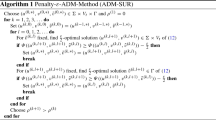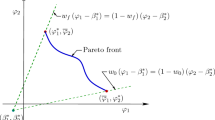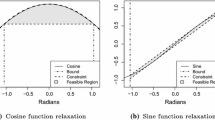Abstract
In this paper we derive an efficient optimization approach to calculate optimal controls of electric transmission lines. These controls consist of time-dependent inflows and switches that temporarily disable single arcs or whole subgrids to reallocate the flow inside the system. The aim is then to find the best energy input in terms of boundary controls in combination with the optimal configuration of switches, where the dynamics is driven by a coupled system of hyperbolic differential equations. We use a well-known three-step optimization approach based on the idea of partial outer convexification, for which we establish that the analytical requirements for its application hold for each fixed spatial discretization of the underlying partial differential equation, provided that combinatorial constraints are only pointwise in time. A comparison with a direct solver yields very promising results, also for problems with from an application viewpoint important switch up-time and down-time constraints, which are not pointwise in time and thus not fully covered by theory.






Similar content being viewed by others
References
Androulakis, I.P., Maranas, C.D., Floudas, C.A.: \(\alpha {\rm BB}\): a global optimization method for general constrained nonconvex problems. J. Glob. Optim. 7, 337–363 (1995). (State of the art in global optimization: computational methods and applications (Princeton, NJ, 1995))
Bahiense, L., Oliveira, G., Pereira, M., Granville, S.: A mixed integer disjunctive model for transmission network expansion. IEEE Trans. Power Syst. 16, 560–565 (2001)
Belotti, P., Lee, J., Liberti, L., Margot, F., Wächter, A.: Branching and bounds tightening techniques for non-convex MINLP. Optim. Methods Softw. 24, 597–634 (2009)
Belotti, P., Kirches, C., Leyffer, S., Linderoth, J., Luedtke, J., Mahajan, A.: Mixed-integer nonlinear optimization. Acta Numer. 22, 1–131 (2013)
Bergen, J., Vittal, V.: Power Systems Analysis, 2nd edn. Prentice Hall, Upper Saddle River (2000)
Berthold, T., Gleixner, A.M.: Undercover: a primal MINLP heuristic exploring a largest sub-MIP. Math. Program. 144, 315–346 (2014)
Bienstock, D., Chertkov, M., Harnett, S.: Chance-constrained optimal power flow: risk-aware network control under uncertainty. SIAM Rev. 56, 461–495 (2014)
Bonami, P., Lee, J., Leyffer, S., Wächter, A.: More Branch-and-bound Experiments in Convex Nonlinear Integer Programming. Argonne National Laboratory, Mathematics and Computer Science Division (2011). Preprint ANL/MCS-P1949-0911
Bonami, P.: Lift-and-project cuts for mixed integer convex programs. Integer Program. Comb. Optim. 6655, 52–64 (2011)
Bonami, P., Biegler, L.T., Conn, A.R., Cornuéjols, G., Grossmann, I.E., Laird, C.D., Lee, J., Lodi, A., Margot, F., Sawaya, N., Wächter, A.: An algorithmic framework for convex mixed integer nonlinear programs. Discrete Optim. 5, 186–204 (2008)
Bonami, P., Cornuéjols, G., Lodi, A., Margot, F.: A feasibility pump for mixed integer nonlinear programs. Math. Program. 119, 331–352 (2009)
Bonnans, J.: Mathematical study of very high voltage power networks I. The optimal DC power flow problem. SIAM J. Optim. 7, 979–990 (1997)
Colombo, R.M., Guerra, G., Herty, M., Schleper, V.: Optimal control in networks of pipes and canals. SIAM J. Control Optim. 48, 2032–2050 (2009)
da Silva, E., Gil, H., Areiza, J.: Transmission network expansion planning under an improved genetic algorithm. IEEE Trans. Power Syst. 15, 1168–1175 (2000)
Dakin, R.J.: A tree-search algorithm for mixed integer programming problems. Comput. J. 8, 250–255 (1965)
Donde, V., Lopez, V., Lesieutre, B., Pinar, A., Yang, C., Meza, J.: Identification of severe multiple contingencies in electric power networks. In: Proceedings 37th North American Power Symposium, LBNL-57994 (2005)
Duran, M., Grossmann, I.: An outer-approximation algorithm for a class of mixed-integer nonlinear programs. Math. Program. 36, 307–339 (1986)
Fisher, E., O’Neil, R., Ferris, M.: Optimal transmission switching. IEEE Trans. Power Syst. 23, 1346–1355 (2008)
Fletcher, R., Leyffer, S.: Solving mixed integer nonlinear programs by outer approximation. Math. Program. 66, 327–349 (1994)
Freeman, R., Karbowiak, A.: An investigation of nonlinear transmission lines and shock waves. J. Phys. D 10, 633 (1977)
Geißler, B., Martin, A., Morsi, A., Schewe, L.: Using piecewise linear functions for solving MINLPs. In: Mixed Integer Nonlinear Programming, Vol. 154 of IMA Volumes in Mathematics and its Applications, pp. 287–314. Springer, New York (2012)
Geoffrion, A.M.: Generalized Benders decomposition. J. Optim. Theory Appl. 10, 237–260 (1972)
Göttlich, S., Teuber, C.: Space mapping techniques for the optimal inflow control of transmission lines. Optim. Methods Softw. 33, 120–139 (2018)
Göttlich, S., Ziegler, U.: Traffic light control: a case study. Discrete Contin. Dyn. Syst. Ser. S 7, 483–501 (2014)
Göttlich, S., Herty, M., Schillen, P.: Electric transmission lines: control and numerical discretization. Optim. Control Appl. Methods 37, 980–995 (2016)
Göttlich, S., Potschka, A., Ziegler, U.: Partial outer convexification for traffic light optimization in road networks. SIAM J. Sci. Comput. 39, B53–B75 (2017)
Goux, J.-P., Leyffer, S.: Solving large MINLPs on computational grids. Optim. Eng. 3, 327–346 (2002). (Special issue on mixed-integer programming and its applications to engineering)
Gross, G., Galiana, F.D.: Short-term load forecasting. Proc. IEEE 75, 1558–1573 (1987)
Grossmann, I.E.: Review of nonlinear mixed-integer and disjunctive programming techniques. Optim. Eng. 3, 227–252 (2002). (Special issue on mixed-integer programming and its applications to engineering)
Hante, F.M.: Relaxation methods for hyperbolic PDE mixed-integer optimal control problems. Optim. Control Appl. Methods 38, 1103–1110 (2017)
Hante, F.M., Sager, S.: Relaxation methods for mixed-integer optimal control of partial differential equations. Comput. Optim. Appl. 55, 197–225 (2013)
Jiang, Y.-L.: Mathematical modelling on RLCG transmission lines. Nonlinear Anal. Model. Control 10, 137–149 (2005)
Jung, M.: Relaxations and Approximations for Mixed-Integer Optimal Control. Ph.D. Thesis, Heidelberg University (2013)
Jung, M.N., Reinelt, G., Sager, S.: The Lagrangian relaxation for the combinatorial integral approximation problem. Optim. Methods Softw. 30, 54–80 (2015)
Kallrath, J.: Gemischt-ganzzahlige Optimierung: Modellierung in der Praxis: Mit Fallstudien aus Chemie, Energiewirtschaft, Metallgewerbe, Produktion und Logistik. Springer, Cham (2013)
Kirches, C., Sager, S., Bock, H.G., Schlöder, J.P.: Time-optimal control of automobile test drives with gear shifts. Optim. Control Appl. Methods 31, 137–153 (2010)
Kundur, P.: Power System Stability and Control. McGraw-Hill, New York (1994)
Lasseter, R.: MicroGrids. IEEE Power Eng. Soc. Winter Meet. 1, 305–308 (2002)
Leyffer, S., Linderoth, J., Luedtke, J., Miller, A., Munson, T.: Applications and algorithms for mixed integer nonlinear programming. J. Phys. Conf. Ser. 180, 012014 (2009)
Linderoth, J., Savelsbergh, M.: A computational study of search strategies in mixed integer programming. INFORMS J. Comput. 11, 173–187 (1999)
Liu, C., Wang, J., Ostrowski, J.: Static switching security in multi-period transmission switching. IEEE Trans. Power Syst. 27, 1850–1858 (2012)
Misener, R., Floudas, C.A.: GloMIQO: global mixed-integer quadratic optimizer. J. Glob. Optim. 57, 3–50 (2013)
Nannicini, G., Belotti, P.: Rounding-based heuristics for nonconvex MINLPs. Math. Program. Comput. 4, 1–31 (2012)
Ostrowski, J., Wang, J.: Network reduction in the transmission-constrained unit commitment problem. Comput. Ind. Eng. 63, 702–707 (2012)
Papalexopoulos, A., Hao, S., Peng, T.: An implementation of a neural network based load forecasting model for the EMS. IEEE Trans. Power Syst. 9, 1956–1962 (1994)
Pecas Lopes, J., Moreira, C., Madureira, A.: Defining control strategies for microgrids islanded operation. IEEE Trans. Power Syst. 21, 916–924 (2006)
Romero, R., Monticelli, A.: A hierarchical decomposition approach for transmission network expansion planning. IEEE Trans. Power Syst. 9, 373–380 (1994)
Sager, S.: Numerical Methods for Mixed-integer Optimal Control Problems. Der andere Verlag Tönning, Lübeck (2005)
Sager, S.: Reformulations and algorithms for the optimization of switching decisions in nonlinear optimal control. J. Process Control 19, 1238–1247 (2009)
Sager, S., Bock, H.G., Reinelt, G.: Direct methods with maximal lower bound for mixed-integer optimal control problems. Math. Program. 118, 109–149 (2009)
Sager, S., Jung, M., Kirches, C.: Combinatorial integral approximation. Math. Methods Oper. Res. 73, 363–380 (2011)
Sager, S., Bock, H.G., Diehl, M.: The integer approximation error in mixed-integer optimal control. Math. Program. 133, 1–23 (2012)
Savelsbergh, M.W.P.: Preprocessing and probing techniques for mixed integer programming problems. ORSA J. Comput. 6, 445–454 (1994)
Smith, E.M.B., Pantelides, C.: A symbolic reformulation/spatial branch-and-bound algorithm for the global optimisation of nonconvex MINLPs. Comput. Chem. Eng. 23, 457–478 (1999)
Soares, A., Gomes, A., Henggeler-Antunes, C., Cardoso, H.: Domestic Load Scheduling Using Genetic Algorithms. Lecture Notes in Computer Science, vol. 7835, pp. 142–151. Springer, Berlin (2013)
Stubbs, R., Mehrotra, S.: A branch-and-cut method for 0–1 mixed convex programming. Math. Program. 86, 515–532 (1999)
Van Roy, T.J.: Cross decomposition for mixed integer programming. Math. Program. 25, 46–63 (1983)
Vielma, J.P., Nemhauser, G.L.: Modeling disjunctive constraints with a logarithmic number of binary variables and constraints. Math. Program. 128, 49–72 (2011)
Vielma, J.P., Ahmed, S., Nemhauser, G.: Mixed-integer models for nonseparable piecewise-linear optimization: unifying framework and extensions. Oper. Res. 58, 303–315 (2010)
Acknowledgements
SG is supported by the BMBF Project ENets (05M18VMA). AP gratefully acknowledges support by the European Research Council within the ERC Advanced Grant MOBOCON (291 458) and by the German Federal Ministry for Education and Research under Grants 05M2016-MOPhaPro and 05M2018-MOReNet.
Author information
Authors and Affiliations
Corresponding author
A Details of the Proof of Lemma 3.3
A Details of the Proof of Lemma 3.3
To ensure a clearer presentation of the proof of Lemma 3.3, we provide a detailed derivation for (27) in the following:
Due to \(\hat{\alpha }_c \le 1\), we get
where we exploit that
The same computations can be done for the remaining summand.
Rights and permissions
About this article
Cite this article
Göttlich, S., Potschka, A. & Teuber, C. A partial outer convexification approach to control transmission lines. Comput Optim Appl 72, 431–456 (2019). https://doi.org/10.1007/s10589-018-0047-6
Received:
Published:
Issue Date:
DOI: https://doi.org/10.1007/s10589-018-0047-6




